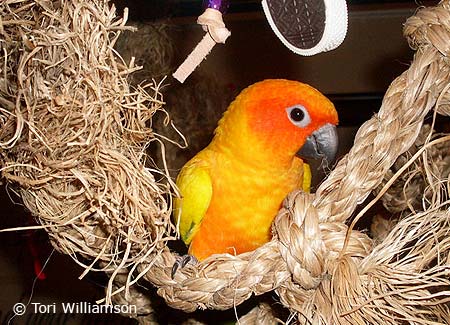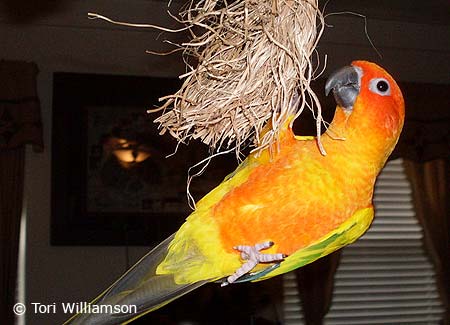|
Sun Conures
Common
Names: Sun
Conure
Scientific
Name: Aratinga
solstitialis
Origin: South America
Relative Size: Small 100-120 grams
Average Lifespan: 20 – 30 years.
Sun Conures as Pets

Then Sun Conure is considered one of the most beautiful parrots
kept in captivity. These small sized parrots are mischievous,
friendly, and active. Of all the conures these are the most
sought. They are not too expensive and they make great pets. A
properly socialized and tamed conure will enjoy spending time with
everyone.
Watching
these conures is a delight to most owners. They climb about their
cages, swing, and hang upside down for laughs. Many owners find
themselves spending hours watching their conure play inside its
cage or on its play stand.
Sun Conures
will gladly sit on your shoulder or climb around your shirt while
doing household duties. Though strangers do frighten them, it
does not take long to warm them up to them. A few good treats
offered by the guest will do the trick.
These birds
are great at performing tricks and will easily do so for affection
or treats. They can turn around, flap their wings, or open their
tail. More complex tricks such as placing coins into a bottle,
pushing carts, or ringing bells can easily be learned too. Use
positive reinforcement and always reward good behavior.
Though they
can learn tricks rather easily they are not good talkers. Some
might learn to speak, but most do not. Their voices are somewhat
clear and raspy, often sounding like and old man. This conure can
pickup a few words if worked with.
Housing A Sun Conure
There cage should be as large as your budget can afford and filled
with toys. Giving the Sun Conure a large cage will allow adequate
exercise while you are away. The cage should be situated inside a
room with frequent activity and noise. These birds should not be
left alone for hours with the cage door open, for curiosity will
get the best of them. This can lead to serious problems or death
if not supervised.
The conure
should also have a play stand as well. This stand should have
toys, ropes, ladders, and food stations. Place the stand high
enough so ropes can be hung from perches. These conures will
spend countless hours swinging and climbing up and down the
ropes.
Toys for a Sun Conure
These birds enjoy toys, especially toys that are easily
dismantled. Use toys that are bird-safe such as small wooden
blocks, chewable leather materials, and knotted ropes. There
beaks may look small, but watch them enthusiastically chew and
untie their toys and ropes. Toys help to simulate your conure and
help to prevent boredom. It’s important to rotate the toys
regularly to prevent boredom.

Sun Conure Noise & Screaming
Of all the problems reported with Sun Conures, screaming is the
most problematic. Their calls are shrill and high-pitched. To
avoid this problem, proper techniques need to be used to help
minimize screaming. It is important to understand that screaming
should be expected during natural call times—early morning, noon,
and before sunset.
Take
your conure out daily to help minimize this screaming. If you wish
to reduce screaming, ignore your bird completely. Most owners
make the mistake of coddling the bird or scolding the bird during
a screaming tantrum. This only reinforces the behavior and makes
it worse.
Sun Conure Diet
A healthy diet is also required if you wish to have a long lived conure. These birds thrive on seeds and fruits in the wild and
should be fed that in captivity too. Having a healthy diet should
keep your conure alive for 20 or more years.
A good diet
will consist of pellets, seeds, fruits, and vegetables. Most
conures do not have problems accepting new foods. Chunks of apple
or peaches make tasty treats. Be sure to include fresh greens
such as spinach, romaine lettuce, or kale.
Cleaning the Cage
The cage should be cleaned daily and washed with a bleach solution
weekly. The solution should be 1 part bleach to 3 parts water.
Use a scrub brush to remove your parrot’s waste with the bleach
solution. Once the cage is scrubbed, rinse the cage thoroughly
until the solution is removed. Repeat the same process with the
perches. After washed, let the cage and perches dry and place
your Sun Conure back into his cage. This will stop harmful
bacteria that could make your bird ill.
|
|
Bathing
Your conure should be given a bath twice a week. A bath restores
the plumage of the conure and keeps him looking in optimal
condition. Most conures don’t have a problem with bathing. Keep
a large sized blow filled with about ˝ inch of water and watch
your conure take a bath. These birds enjoy water and it is
healthy and fun for them.
|
|


